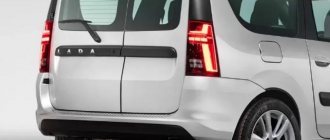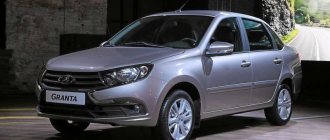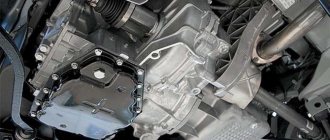Lada Niva Travel has excited the automotive market with a new design, previously unseen on VAZ models. This brutal SUV with increased dimensions began to look brighter and more aggressive. But let's be honest and reveal all the disadvantages and disadvantages of the new product.
The main ones:
- weak engine;
- increased fuel consumption;
- uncomfortable rear seats;
- unfinished heater settings.
Characteristics of Niva Travel
| Engine | 1.7 l. |
| Power | 80 hp |
| Torque | 127 N/m at 4000 rpm |
| Transmission | 5 manual transmission |
| Acceleration to 100 km/h | 19 p. |
| Max. speed | 140 km/h |
| Wheelbase | 2450 mm |
| Body length | 4099 mm |
| Clearance | 220 mm |
| Trunk volume | 320 l. |
| Fuel consumption | 10.2 l. |
| Weight | 1485 kg |
Lada Niva Travel: what has changed and is there a future?
The former Chevrolet Niva returned to the fold of AVTOVAZ, but is still called in Latin - Lada Niva Travel. On the updated Niva Tra... or Travel? In a word, on Nivatrevel I made my way along protected paths from Togliatti to Samara, and along the way I tried to find out whether ex-Shniva had a future.
The Chevy Niva was supposed to change its appearance back in the days of the GM-AVTOVAZ joint venture - it was then that the design idea was formulated and the first sketches were made. But political changes occurred at the plant, the joint venture ceased to exist, and VAZ chief designer Steve Mattin joined the work on the project. The car was already polished by the Lada-Design factory studio. And thank God that they brought the matter to the end, because Shniva’s only “facelift” was done back in 2009 by specialists from the Bertone studio - then the car was simply wrapped in plastic.
This time, the designers also waved the brush carefully, without touching the power structure of the body - this was the requirement of the technologists. But instead of a sweeping, dull face, Niva Travel received a modern nose with multi-level architecture and narrow headlights, which have built-in daytime running lights. The high beam in them now works simultaneously with the low beam. In place of semicircular wheel arches there is a fashionable rectangular profile, bumpers are unrecognizable, and bright LED lights have appeared at the rear. The grimace of capitalism: work is already in full swing in China on cloning this lighting technology for pre-restyling cars.
But the designers did not touch the interior, and the same fusion reigns in it. A well-made and quite modern multimedia “head” (it now greets passengers with the native Lada logo) is equipped with navigation, a Bluetooth interface and USB sockets for connecting gadgets.
But next to it is an ancient microclimate control unit - with terrible rotating knobs, “spotty” lighting and a recirculation damper, similar to a furnace valve. And Nivatrevel’s instrument cluster is just as ancient and “spotty”. Under the armrest there is a small box with a USB power connector and small cup holders. At the slightest roll or simply tilting the car, their contents will fall out onto the riders. And then it will spill out. In addition, to get to the parking brake lever, the armrest has to be folded down - and this is an unnecessary movement.
For some reason, the joystick for electric mirrors is located at the bottom of the center console. He bent down and pressed. He straightened up and looked in the mirror. And so several times - like a Chinese dummy. The longitudinal adjustment bracket of the chair is made for long-armed people, and an ordinary person simply cannot reach it. Well, the rotating knobs of the transmission levers seem to be a retro reference to the times when Lada Niva Travel was also called VAZ-2123.
But visibility is excellent, and the windshield of the Luxury version for 891 thousand rubles is electrically heated. The rear view camera - which, alas, is installed only on “luxury” cars - now has a washer (the fluid supply tube and nozzle are located in the rear bumper). It turns on simultaneously with washing the rear window and knocks dirt off the lens. Works!
But Travel in the Off-Road version is just marketing. There are no traction or geometric advantages, except that the potential depth of the ford thanks to the snorkel is increased from 30 cm to half a meter. I think that an ordinary car will also take half a meter - if you don’t rush and “drive the wave” correctly.
But Travel Offroad looks beautiful. In addition to the air intake pipe (it is hidden behind the A-pillar), such cars are equipped with 16-inch matte wheels with Cordiant All-Terrain tires and a dark headliner. The minimum price is 845 thousand rubles.
Nothing new in terms of technology. An ancient engine with a volume of 1.7 liters and a power of 80 hp. (it was driven to Euro 5 requirements) with an amorphous, uninformative accelerator and a very narrow operating range. The power supply is weak, and on other fronts Nivatravel does not shine with weapons: in the basic configuration there is only one airbag, and even the top versions do not have a stabilization system. The transmission works well, but the forces on the levers are large, the backlash provokes shocks, and the central differential lock is activated only when driving, when the gas is released and with a muscular jerk of the lever. Oh, nostalgia!
But that’s not why we love Niva, right? And first of all, for driving comfort. For the suspension, which does not notice many obstacles, for the absence of hard impacts and body sway. We also like Niv’s off-road geometry, and the gutta-percha quality of the suspension seems unrealistic - the last time I moved such large logs was only on an ATV. And if Nivatravel is stuck, but moves at least a little, then, as a rule, it moves out under its own power - it has been tested in snow, sand, and mud. And the transmission does not overheat.
The price, of course, bites - from 748 thousand rubles. But you still can’t buy anything new for this money. And the current restyling has even improved the consumer qualities of the car in some ways: the Niva Travel now has two tow lugs in front and back - rural residents will appreciate this.
But the townspeople have no need for this - those 18 thousand Nivas that were sold here last year ended up in the regions, and 35% of their number came from corporate purchases, including through the state. By the way, the classic Niva, which is now Niva Legend, is selling better: last year’s result was 27,480 cars. And if just six months ago it could be said that the plant would produce both models as long as there was demand for them, today the situation has changed radically. Neither car fits into the recently announced Renaulution strategy (AP No. 2, 2021), which implies the technological unification of Lada with the Romanian company Dacia and technological unification on the modular CMF-B platform.
And whether they need to be included there is also unclear. After all, cars with such off-road characteristics cannot be built on a new platform. It is obvious that Niva Travel has been vaccinated against unification: restyling in order to free up a niche in three or four years is not the VAZ way. The certificate for such a Niva will be valid for at least another three years, during which time AVTOVAZ most likely will not have time to prepare the converted Niva-3. And even after its appearance, Lada may get an interesting ladder of models under a separate Niva brand, as Renault wants. It’s difficult to imagine prices in such a perspective, but if the Niva-3 turns out to be a little cheaper than the Duster (relatively, up to a million rubles “in the base”), then both the Niva Travel (from 750 thousand) and the three-door Niva Legend (from 600 thousand) will easily fit on this ladder thousand). As long as Russian environmental and safety requirements allow this.
Engine and transmission
Under the hood of NIVA Travel there is a good old VAZ naturally aspirated engine with four cylinders and a power of 80 hp. Unfortunately, buyers of this model will not see anything more interesting.
The unit has enough power for off-road use, thanks to the reduction range of the transmission. The track requires something more powerful, especially if you have the air conditioning on. The Niva won’t go far in snowdrifts either. It is advisable to have something solid under the wheels.
But you will have to go up the hill, turning on third gear. Modern cars accomplish the same task in fourth gear.
As for acceleration, Niva Travel cannot be called an overtaking car. The actual time it takes it to reach 100 km/h (on asphalt with studded tires) is 21.6 seconds. Compared to the stated 19 s, this is not a very dynamic result.
The increased fuel consumption is also not encouraging. In the city in winter, a car consumes up to 18 liters of gasoline.
Starting the engine in cold weather also causes difficulties. At -20 degrees, the car will require driver assistance with fuel supply.
The engine cooling system requires frequent checks, especially at the pipe connections. And the gearbox will serve you faithfully up to 50,000 km. Then you will have to sort it out.
Another weak point of the engine compartment is the hydraulic timing chain tensioner. It cannot cope with its function for a long time, so after a short period of time it needs to be replaced.
On the asphalt
Yes, yes, the engine and transmission are the ones that are “old”, but not so “good”. 80 hp and 127 Nm is always not enough for an all-wheel drive SUV. To stay in city traffic, the engine must be revved; on the highway, every overtaking will have to be calculated, even when there is only a driver and one passenger in the cabin, and with a full load (if you have experience!) everything becomes even more difficult.
In addition to this, the power unit is openly vibration-loaded and is not at all quiet. True, with the Travel prefix Niva received improved sound insulation - and you can feel it on the highway! If at city speeds the transmission is a little audible, then as you reach high speeds the engine also begins to “sound”. But aerodynamic noise and sounds from the road do not bother you at all: you drive “hundreds” and can calmly talk without raising your voice. In general, there are surprisingly no complaints about acoustic comfort.
The steering wheel, which is a little heavy when maneuvering, turns out to be just right on the highway: even if the “zero” is not very clear, the car confidently goes in a straight line, directional stability during such movement does not give any reason for criticism, and unlike the Niva Legend with its short wheelbase, this the SUV is not a jerk.
True, you need to be more careful when turning: Niva Travel is ready to go into them with pleasure, but then this turns into oversteer, noticeable rolls and a lack of response to control actions. In general, if there is a sudden detour around an obstacle, the driver will have to work hard to maintain control over the car and carry out the intended maneuver without leaving the intended trajectory. ESP would help here - alas, it doesn’t exist.
In general, it is better to drive the Niva Travel slowly on public roads, ideally preferring gravel and dirt paths and “directions”. After all, this is where the Russian SUV reveals its best side.
Chassis
The Lada performed well off-road. The more bumps on the road, the more comfortable it is to drive in the car. However, on the highway, at speeds above 100 km/h, the driver begins to feel insecure. The reason is the steering column, which loses the sense of directionality of the wheels.
Car owners also complain about the center differential locking function. It turns on manually and not the first time. The lever periodically sticks, causing problems with turning the lock on or off. This causes discomfort for the driver off-road.
As for sound insulation, at speeds exceeding 100 km/h, the howl of the transmission begins to be heard.
The wheel bearings on the new model remain the same, so at the first replacement, it is better to supply alternative components.
Electronic systems
Niva Travel can rightfully be called an “honest” SUV, since it copes with off-road conditions on its own, without any auxiliary electronic systems (there is only an ABS system). Drivers will need to be especially careful on slippery road surfaces, because there is also no stabilization system.
Top trim levels have two front airbags, while base trims have only one for the driver.
Another small but important detail is that the Niva Travel headlights fog up. Bosch halogen optics are not lensed, as was the case in the Chevrolet Niva.
Interior
All the disadvantages of the interior come down to the uncomfortable rear row seats with adjustable backrests. There will be little space for passengers, and there is absolutely nowhere to stretch their legs. Your knees will rest against the back of the person riding in front, and your head will rest against the ceiling (if you are tall).
If you are short, you may find it a little difficult to reach the gear lever.
The heater, which perfectly adapts to the driving conditions, deserves special attention. But this doesn’t make it any easier for the driver, because the temperature in different modes with one position of the regulator changes greatly. Therefore, the cabin becomes either hot or cold.
The noise from the stove will keep passengers from falling asleep, but it will keep the driver awake. By the way, it blows weaker at the front passenger’s feet than at the driver’s feet.
The restyled version received a different dashboard design. It has become less readable compared to the original model. The absence of digital elements brought back the seasoned flavor of Niva.
Another small detail: the heated seats are not adjustable.
Seem modern
It all starts with the key. It could easily be a symbol of the entire car: it tries to be modern, but remains, in fact, archaic. A simple body, narrow keys that you have to feel to get into. But the remote lock is there and working, the key blade pops out of the key fob regularly.
The car itself is the same. By using new bumpers and optics, replacing a number of body parts (hood, grille, wheel arch trims, etc.), they tried to give the age-old model a modern look, and the result was a generator of jokes about comparisons with the new RAV4.
Although, in fact, from some angles Niva Travel looks good and original, from others it is not much different from the previous one, but if you look strictly from the front... Okay, let's not talk about Toyota.
The interior remains completely the same. Decorated in dark colors, it looks not only outdated, but also too gloomy. The multimedia screen sticking out from the front panel is a reminder that the car is trying to keep up with the times.
Again, the minimum set in the form of front airbags, ABS, air conditioning and even heated windshield over its entire area is available, albeit in expensive versions. And even the steering wheel (now with the Lada emblem) is adjustable for tilt.
But ergonomics remained in the 20th century, and there are questions about working out the details. The air conditioning is turned on with a separate button on top, multimedia is controlled on the panel below. You turn off the engine, take out the key - the running lights and fog lights continue to light, and the sound signal only sounds for a few seconds. Moreover, the multimedia system also continues to work - it’s impossible to drain the battery with so many remaining active consumers!
But for its compact size, the inside of the Lada Travel is perceived as spacious even by modern standards. Two adults can fit in the back with good comfort, and if they are of a slight build or teenagers, then three of them can sit well.
And again, given the compact dimensions of the car, the trunk is quite roomy, and also practical: the door opening is large, the shape of the compartment itself is close to a parallelepiped, plus we don’t forget about the possibility of transformation. In general, everything is as it was, but here we cannot say that this is yesterday. Unlike…











